(derived from a webinar 1 July 2020 and a whole bunch of other sources)
In 1975, Rudi Schreiner boarded a raft on the Amazon River and thought that this is the way to travel. This raft was anything but luxurious, with an outboard motor and a simple covering. He got the idea of maybe something like this could be done on Europe’s rivers.
Europe’s Major Rivers
If you look at a map of the various rivers of Europe, you will see some of the major ones: Rhine, Danube, Rhône, Seine, Dneiper, Dvina, Pechora.
They flow from the center of Europe that is elevated to one of the surrounding seas. The Pechora and Dvina flow into the Arctic Ocean. Flowing into the North Sea are Rhine, and Elbe. Into the Baltic are the Oder and Vistula. Into the Atlantic are the Loire and Seine which have a high volume of water because of rainfall. Also Douro and Tagus in Portugal. Into the Mediterranean are the Rhône, Tiber and, Ebro. The Black Sea collects the Danube and Dneiper. A small sea, Azov gets the water of the Don. And the Caspian Sea collects the water of the longest river in Europe, the Volga which is 3960 km long. Another river going into the Caspian is the Ural. The Loire River empties into the Bay of Biscay. The Po River ends in the Adriatic Sea.
The Rhine
Our concern in 2021 is the Rhine River. It rises at an altitude of 2344 meters from two small headways in the Swiss Alps and then flows first northward and then northwest. Like the Danube, it has been an important navigable river since the Roman Empire, functioning as a medieval superhighway as it encouraged trade between the various duchies and principalities that eventually coalesced into the nations of Switzerland, Austria, Germany, France, and the Netherlands. As it goes through different countries, its name changes. So in Germany it is the Rhein, in France it is Rhin, and the Netherlands – where we join it, it is called the Rijn.

Consider the possibility of each nation imposing tolls and special controls on its portion of the river, so one of the provisions of the Treaty of Vienna that ended the Napoleonic Wars in 1815 created an international waterway from its mouth to the German-Swiss border.
As we work our way up the Rhine, notice the many castles and fortifications. Probably the most famous is Neuschwanstein, built by “Mad” King Ludwig in the 19th century.

Unfortunately, it is in Bavaria, far to the east of our trip itinerary, but there is a rumor that Walt Disney was so impressed with it, that he copied much of the idea for Disneyland (or Disneyworld, or maybe both). If you have not seen the apartment/condo/hotel complex southwest of Grand Rapids in Grandville, take a look at the Grand Castle Apartments

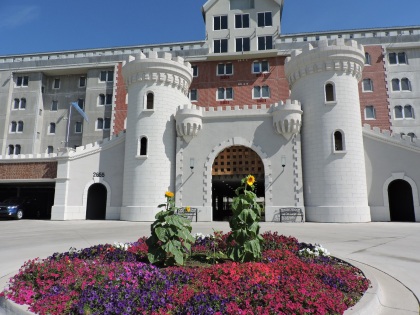
Our voyage will give us the chance to see the spectacular Rhine Gorge, where the river has cut a path into the rock for 40 miles. Today, this is a UNESCO World Heritage Site with medieval villages and fields of wine-bearing grapes.
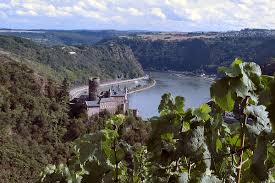
For purposes of navigation and to prevent flooding, the river has been altered. For example, near Lake Constance, it was straightened and the banks have been built up. We won’t see that as we depart our ship in Basel (where, by the way, the name of the river changes to Hochrhein or “High Rhine.”)
Because water transportation is probably the cheapest and most economical way to ship goods, and because the area that the Rhine flows through has an abundance of raw materials, the river became a major axis of industrial production. Currently, approximately 20% of the world’s chemical industries are produced along the Rhine. Think of your own home town and the history of the local river being a dumping site for excess materials. This is also true for the Rhine as pollution levels have risen and many toxic substances are in the water, although titanic efforts are being made to clean it up.
What to Look for on our river journey

Before we board AmaMora in Amsterdam on 5 August, we start with a panoramic tour of Amsterdam and then have some additional free time to maybe catch one of the museums we missed.
On 6 August, after breakfast, we debark from AmaMora and board a small vessel for a canal cruise. Later in the day, we set off on the Rhine River cruise. But we will not initially be on the Rhine because it empties into the North Sea at Rotterdam 78 kilometers to the south, through the New Waterway Canal completed in 1872. Instead, we travel on the 1952-finished Amsterdam-Rijnkanaal through the very flat territory that is part of the Rhine delta. We will be on this canal for about 72 kilometers (convert to 45 miles). It averages 100 meters in width. In 1986, the Delta Project was completed where all main branches of the Rhine were closed off and a series of channels carry excess water into the North Sea.
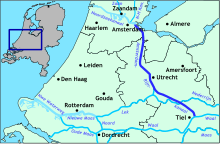
We will pass through Utrecht on our journey to the Waal River near Tiel, negotiating four locks. This is the most-heavily used canal in western Europe so be prepared to see not only other passenger ships but also freighters, either self-propelled or tugs pushing or pulling as many as four 3000-ton lighters. This canal has a minimum depth of 5.5 meters.
Remember that AmaMora, like other ships that traverse the Rhine, must be designed to fit in the locks both for length and width as well as draft. As a result, most river steamers look surprisingly similar. In addition, as there are bridges crossing the canals and rivers, the height above water is also carefully engineered. Many of the river steamers have a “disappearing” pilot house that is on the top deck, that is lowered as low bridges appear on the river journey. By the way, the Dutch word for bridge is brug.
Utrecht (population around 260,000) has several bridges that we will be passing under. Although we will not stop here, look to the port side to see St. Martin’s Cathedral with its famous Dom Tower that should be visible. Utrecht is an historically important city because it was here that the War of Spanish Succession ended in 1715 with an eponymous treaty. The Peace demonstrated the primacy of British power and established the principle of national sovereignty. It also shifted control of the territory that we now call Netherlands to imperial Spain. Here is some additional information on Utrecht
We will also pass by the town of Wijk bij Duurstede where Jacob Ruisdael found that fantastic windmill
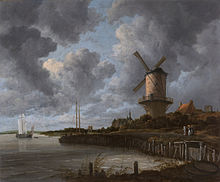
Connection with Rhine River
After this fairly easy beginning, we make a left turn and enter the Waal River and from there to the Rhine at Millingen man de Rign. Our ship will travel all night. Prepare for a great dinner and entertainment afterwards!
The next morning on 7 August, we arrive in the German city of Cologne (Köln) for a guided tour of the old town and the fantastic Gothic Cathedral.
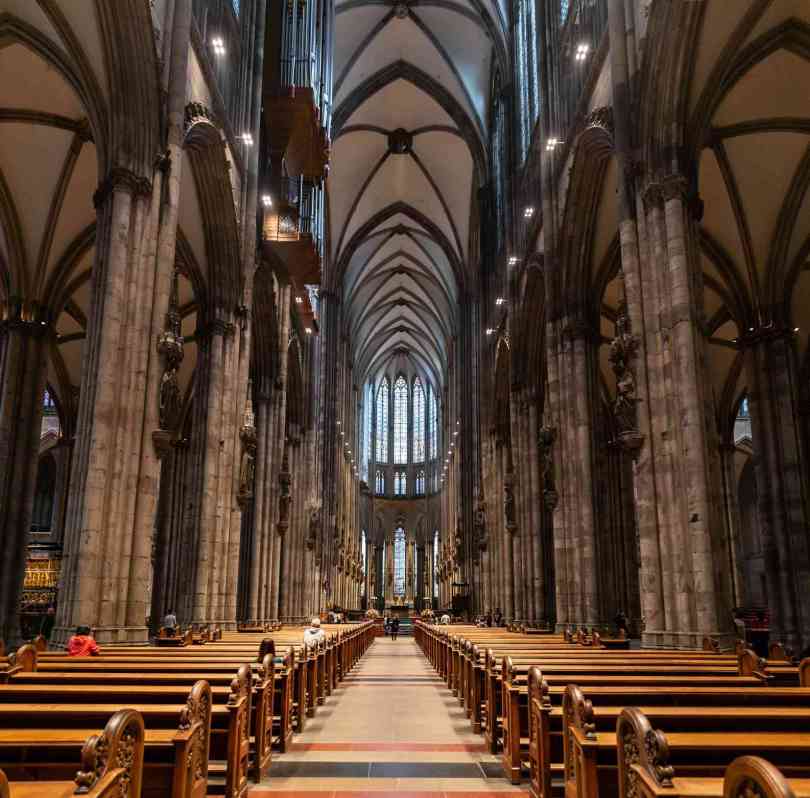
Remember that while we are in the Netherlands, Germany, and France, we are guests of the European Union and there is no discernable issue with crossing borders or with using the Euro € as our currency. However, Switzerland has chosen to remain independent from the European Union, even though the EU is Switzerland’s largest trading partner. So while in that nation, we will be using Swiss francs as our currency. Of course, Visa and MasterCard are accepted widely – pay in the local currency and let your credit card make the conversion; you will get a better exchange rate.
While in Cologne, we will visit the Rathaus (town hall), the Overstolzenhaus (a great example of Romanesque architecture built around 1250), the Festival Hall, and possibly a local tavern to sample Kölsch beer and reibekuchen mid apfelmus (potato pancakes with applesauce).
The next day, 8 August, should be spectacular. We will travel through the Rhine Gorge. Here, for 65 kilometers, from Koblenz to Bingen, we will see some of the famous 40 castles, many which have converted to hotels, restaurants and museums. [Rhine castle] Some of these castles can be traced back to the 9th century and they continued to be built up to the 15th century. Gunpowder had made its way into Europe in the 14th century, but used primarily for small arms at very close range. Not until cannon were introduced in what seems to be perpetual warfare in the 15th century that could destroy the stone towers of the castles.
Some of you were with me in our trip to northern and eastern Spain in 2006, when we made a day trip from Madrid to Segovia and the Valley of the Gods. In Segovia, although we did not have a chance to enter, the Alcázar castle was quite awe-inspiring (it was also to Walt Disney, who used it as a model for building Cinderella’s castle).
Keep in mind that there was NO nation of Germany in the Middle Ages, but rather a series of kingdoms, grand duchies, duchies, principalities, provinces, and independent cities with the overarching Holy Roman Empire attempting overall control. The final unification did not occur until 1871.[figure out a way to put this in a box to not disrupt the flow] If you are interested in a short history of Germany, close this article and open the one entitled “A Short History of Germany.
But be sure to come back here!
The Rhine Gorge is in the upper half of the Middle Rhine (Mittelrhein). Besides the castles and the gorge that was caused by water erosion over time, on the starboard side around 30 kilometers upriver from Cologne, you might be able to see Bonn. This was the capital of the Federal Republic of Germany. Beginning after Germany’s defeat in World War II, what was known informally as West Germany had its capital moved from Berlin to Bonn, in large part to negate the past. So Bonn was the capital of West Germany while East Berlin was the capital of East Germany (German Democratic Republic). Following the reunification of the two different nations, eventually in 1999 the unified capital was returned to Berlin.
Also on the starboard side, you should be able to see the Mosel River flowing into the Rhine. When you hear Mosel, do you think of wine? In France, where the river rises, it is called Moselle. We will stop at Rüdesheim, a true winemaking town. While there, we will be treated to a gondola ride to Niederwalkdankmal Statue, and then a wine tasting. Maybe you might prefer to hike through the vineyards and take a guided bike tour to Schloss (castle) Johannisberg.
While we are in Rüdesheim, we can taste Rüdesheimer Coffee that is made with coffee, brandy, and whipped cream.
It is wonderful that our river cruise offers alternative land excursions. Right now, I count five choices while we are in Rüdesheim. But like other shore stops (or should I call them “bank” stops?), we get underway once again to get to our next adventure the next day.
Our moving luxury hotel stops the next morning, 9 August, in Ludwigshafen. If you are up early, you might sense that when we pass the city of Mainz on our starboard side, the river is now predominantly flowing north. We will be in Rhineland-Palatinate. Further downriver, when the river makes an almost 180º turn to starboard, we will pass the town of Hamm am Rhein. (There has to be a joke here!) The Rhine here forms the boundary between Rhineland-Palatinate and Hesse. We then pass Worms on our starboard side. This is one of the oldest cities in northern Europe, predating Roman times. This is a Latin name, but pronounced as German names where the “W” takes the sound of a “V.” In 1521, an assembly of the Holy Roman Empire met here in what was called a Diet to determine how political and religious authorities should respond to Martin Luther’s teachings. (Remember that he had nailed his 95 Theses on the cathedral door in Wittenberg in 1517. It was at Worms that Luther declared: “Here I stand, I can do no other…God help me. Amen.”
Ludwigshafen is on the west bank of the river. This town of approximately of 170,000 is almost directly across the Rhine from Mannheim (Remember the “Mannheim Steamroller”?) that is in the German state of Baden-Württemberg. The attraction for most of the group, however, will be to cross the river and travel about 10 miles to Heidelberg on a choice of one of two excursions. Surely, you will not want to miss Heidelberg Castle and the Great Vat (an 18th century 49,000-gallon wine cask. A third choice is to travel to Speyer, a road trip of about 30 kilometers where the largest Romanesque cathedral in Europe stands majestically.
As all of the other excursions, we will get much more information on each one before we select.
After we reboard AmaMora, we continue traveling up the Rhine and our next stop the next day on 10 August in Strasbourg. I am assuming that the ship will have a detailed map of where we are on the Rhine. For those who did not elect the previous day to excursion to Speyer, we will pass by it as the river makes a reverse “C” and we will be traveling southwest. Maybe we can see the cathedral from the sundeck. After we pass Karlsruhe on the port side and the little town of Rheinstetten, we will experience an interesting phenomenon: Germany will be on the port side and France will be on the starboard side.
Strasbourg is the capital city of Alsaçe (remember that Bismarck took this province and Lorraine from France after the quick Franco-Prussian War in 1871, but France gained the two provinces back in the 1918-19 Treaty of Versailles that ended World War One.)
This city is currently the formal seat of the European Parliament. You will marvel at the medieval architecture and the cathedral as the city was founded in 1262.
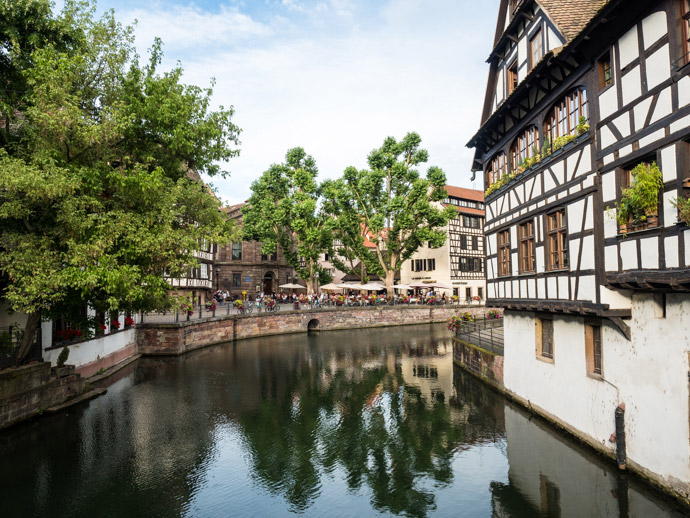
Even though the official language here is French, the locals speak Alsatian, which is a southern German dialect with French overtones. We will experience a similar dialect in parts of Switzerland.
By the way, don’t worry about currency differences when we alight from AmaMora, as the Netherlands, Germany, and France all use the Euro (€). As on previous days, you will have a choice of excursions to experience, either “The Gem of Strasbourg” tour or a Strasbourg bike tour. Those with me in Vietnam several years will understand why I intend to not do the bike tour. In the Gem tour, we will see the Parc de l’Orangerie, the European Parliament and Place de la République, then walk through “La Petite France” district. You will see another Cathédrale de Nôtre Dame.
11 August we wake to the city of Breisach. To make the Rhine navigable this far from the mouth, they dug several canals parallel to the original river that we will be traveling on. Again, there is a choice of excursions. It appears that we will not be spending time in Breisach in organized tours, but the ship’s passengers will split up. Some will spend time in the very small village of Riquewihr. Here, the 16th century comes alive once again after the 15-mile coach trip. I am sure that we will pass through the larger town of Colmar on the way. Travelers come from all over the world to see the architecture and sample the Reisling wine in Riquewihr.
An alternative 16-mile excursion goes to Freiburg in Germany to see the Freiburg Münster, the Gothic cathedral said to have the most beautiful spire in the world.
A third alternative is a biking tour through the countryside or hike in the Black Forest (Schwartwald).
12 August our ship enters the last country we will visit, Switzerland; and we leave the ship in Basel. I am sure that you will be given plenty of warning to pack the night before.

